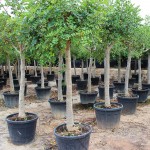CAROB TREE
CERATONIA SILIQUA
Family: Caesalpiniaceae (Leguminosae)
Common name: Carob, carob tree, ceratonia siliqua, St. John’s bread.
Origin: Mediterranean area.
Etymology: Ceratonia, from the Greek term keration, is related with horn shape of its fruit. Siliqua, from the Latin, is the original name of the fruit. This species of tree is highly cultivated in places where animals are raised or areas that need shelter from the sun.
Minimum Temperature: -5º C
The carob is a tree that withstands droughts and that would rather be cultivated in limestone soils. The ceratonia siliqua is especially bought for the shade that it offers, as its height average is 5mt. It can get even until 10mt height and is a perennial species.
The ceratonia siliqua sturdy tap root has a laid out root system. This tree species is one of the most difficult ones to replant due to its gripping ability. However, our nursery Valero e Hijos has experts able to perform the carob replantation with great results.
The carob tree is cultivated for its fruit, especially in the Iberian Peninsula, as the carob bean is used to feed the cattle and even as nourishment during decades of hardship. It is also possible to make diet chocolate with carob beans. The ceratonia siliqua is a valued shade tree in areas with scarce rainfall. That is why carob trees are bought for arid areas as it barely needs to be irrigated. In gardening, this tree is used also isolated.
One of the ceratonia silicua of carob tree disadvantages is its slow growth. Due to this fact, it is usually bought in plant nurseries where the tree is already developed and the only thing that it needs is to be replanted.











